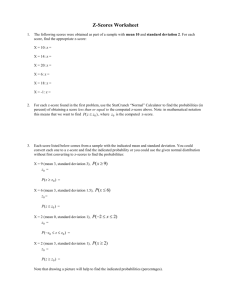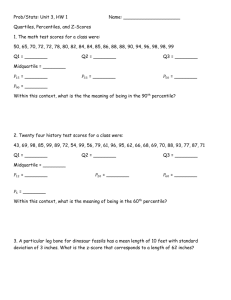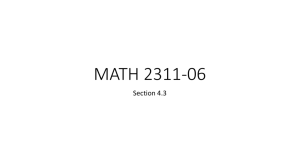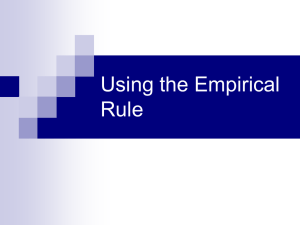MDM4U Normal Distributions
advertisement
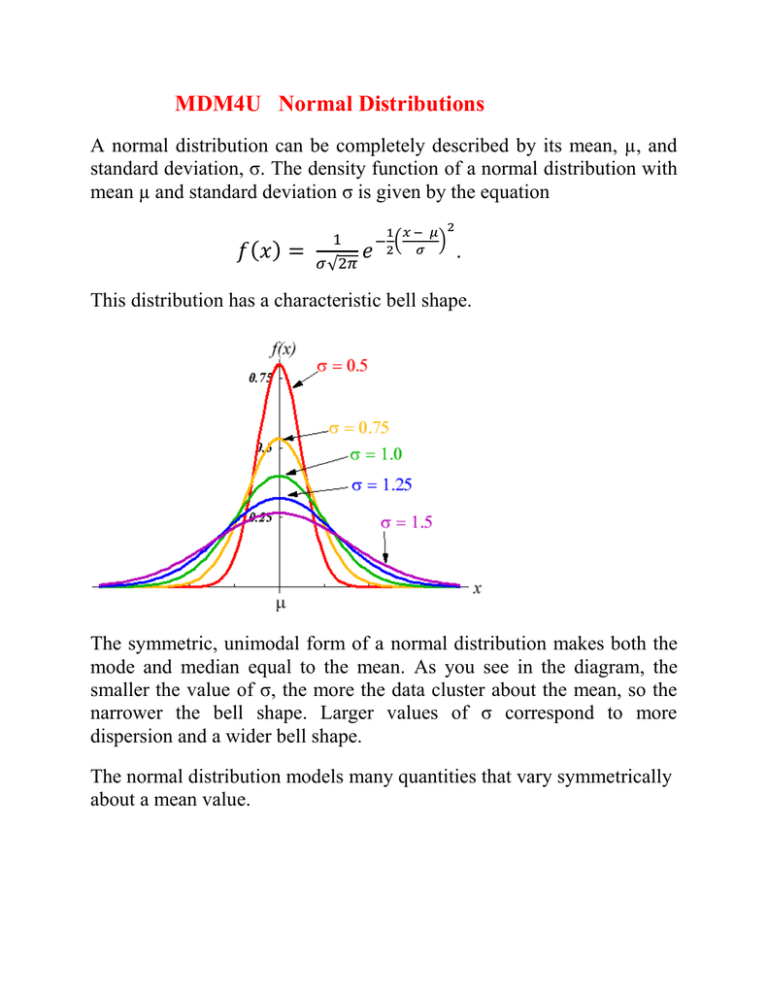
MDM4U Normal Distributions A normal distribution can be completely described by its mean, µ, and standard deviation, σ. The density function of a normal distribution with mean µ and standard deviation σ is given by the equation 𝑓 (𝑥 ) = 1 𝜎 √2𝜋 𝑒 1 𝑥− 𝜇 2 ) 2 𝜎 − ( . This distribution has a characteristic bell shape. The symmetric, unimodal form of a normal distribution makes both the mode and median equal to the mean. As you see in the diagram, the smaller the value of σ, the more the data cluster about the mean, so the narrower the bell shape. Larger values of σ correspond to more dispersion and a wider bell shape. The normal distribution models many quantities that vary symmetrically about a mean value. Notice that, for any normal distribution X, • Approximately 68% of the data values of X will lie within the range µ − σ and µ + σ • Approximately 95% of the data values of X will lie within the range µ − 2σ and µ + 2σ • Approximately 99.7% of the data values of X (almost all of them) will lie within the range µ − 3σ and µ + 3σ Example 1 Predictions from a Normal Model Giselle is 168 cm tall. In her high school, boys’ heights are normally distributed with a mean of 174 cm and a standard deviation of 6 cm. What is the probability that the first boy Giselle meets at school tomorrow will be taller than she is? Solution Random variable X = “boy’s height”. We need to find 𝑃 (𝑋 > 168). For this distribution, 168 = µ − σ. So, we can use the fact that, for any normally distributed random variable X, 𝑃(µ − 𝜎 < 𝑋 < µ − 𝜎) ≈ 68%. Since the heights of boys are normally distributed with mean µ = 174 cm and standard deviation σ = 6 cm, 68% of the boys’ heights lie within 1σ (6 cm) of the mean. So, the range 168 cm to 180 cm will contain 68% of the data. Because the normal distribution is symmetric, the bottom half of this range, 168 cm to 174 cm (the mean value), contains = 34% of the data. Therefore, 𝑃 (𝑋 > 168) = 𝑃(168 < 𝑋 < 174) + 𝑃(𝑋 > 174) ≈ 34% + 50% = 84% So, the probability that Giselle will meet a boy taller than 168 cm is approximately 84%. Probabilities for normally distributed populations, as for other continuous distributions, are equal to areas under the distribution curve. The area under the curve from x = a to x = b gives the probability 𝑃(𝑎 < 𝑋 < 𝑏) that a data value X will lie between the values a and b. No simple formula exists for the areas under normal distribution curves. Instead, these areas have to be calculated using a more accurate version of “counting grid squares.” However, you can simplify such calculations considerably by using z-scores. Z-Scores A z-score is the number of standard deviations that a datum is from the mean. You calculate the z-score by dividing the deviation of a datum by the standard deviation. 𝑧= 𝑥−𝜇 𝜎 The distribution of the z-scores of a normally distributed variable is a normal distribution with mean 0 and standard deviation 1. This particular distribution is often called the standard normal distribution. Areas under this normal curve are known to a very high degree of accuracy and can be printed in table format, for easy reference. A table of these areas is placed below. Areas under the Normal Distribution Curve The table lists the shaded area for different values of z. The area under the entire curve is 1. Example 2 Normal Probabilities All That Glitters, a sparkly cosmetic powder, is machine-packaged in a process that puts approximately 50 g of powder in each package. The actual masses have a normal distribution with mean 50.5 and standard deviation 0.6. The manufacturers want to ensure that each package contains at least 49.5 g of powder. What percent of packages do not contain this much powder? Solution Using a Normal Distribution Table Let X be the mass of powder in a package. The probability required is P(X < 49.5). This probability is equal to the shaded area under the normal curve shown below. To calculate 𝑃(𝑋 < 49.5), first find the corresponding z-score: 𝑧= 𝑥 − 𝜇 49.5 − 50.5 = = −1.67 𝜎 0.6 Use the table above to find the probability that a standard normal variable is less than this z-score. The table gives an area of 0.0475 for z = –1.67, so 𝑃(𝑋 < 49.5) = 𝑃(𝑍 < −1.67) ≈ 0.0475. So, 4.8% of packages contain less than 49.5 g of powder. Example 3 Standardized Test Scores To qualify for a special program at university, Sharma had to write a standardized test. The test had a maximum score of 750, with a mean score of 540 and a standard deviation of 70. Scores on this test were normally distributed. Only those applicants scoring above the third quartile (the top 25%) are admitted to the program. Sharma scored 655 on this test. Will she be admitted to the program? Solution Calculate Sharma’s z-score: 𝑧= 𝑥−𝜇 𝜎 = 655 −540 70 = 1.64. 𝑃(𝑋 < 655) = 𝑃(𝑍 < 1.64) ≈ 0.9498. Sharma’s score is, therefore, just below the 95-th percentile for this test. At least 94% of all those who wrote this test scored lower than Sharma. Key Concepts • The normal distribution models many quantities that vary symmetrically about a mean value. This distribution has a characteristic bell shape. • The standard normal distribution is a normal distribution with mean µ = 0 and standard deviation σ = 1. Probabilities for this distribution are given in the table above. This table gives probabilities of the form 𝑃(𝑍 < 𝑎). 𝑥−𝜇 • A z-score, 𝑧 = , indicates the number of standard deviations a 𝜎 value lies from the mean. A z-score also converts a particular normal distribution to the standard normal distribution, so z-scores can be used with the areas under the normal distribution curve to find probabilities.


